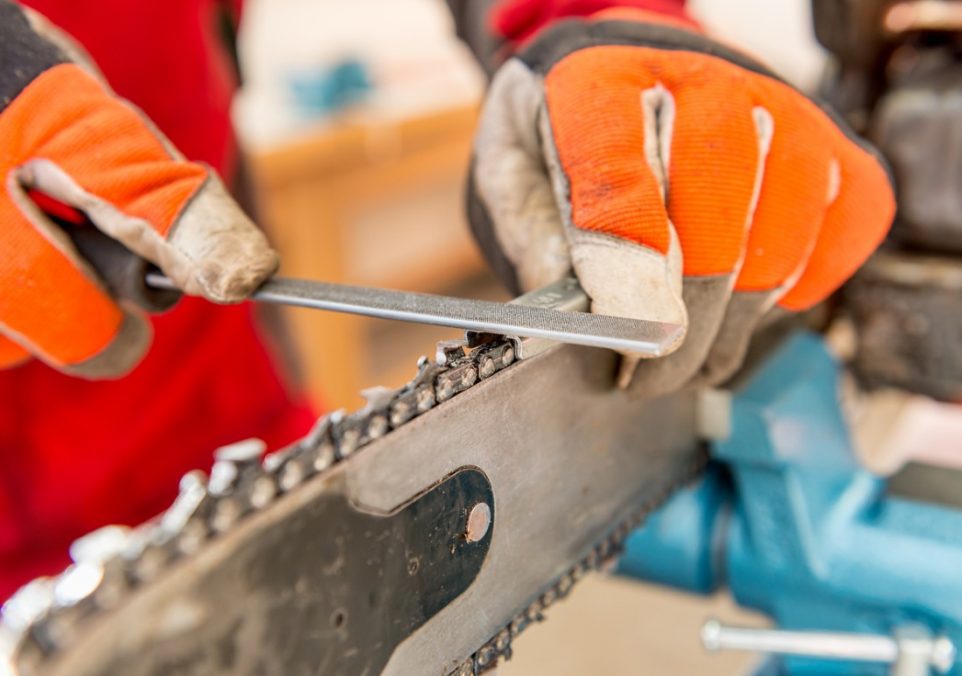As for bar oil, don’t cut corners. Bar oil is specially formulated to stick to the chain and bar, providing the lubrication needed to keep things running smoothly. Using alternatives like motor oil might seem like a good idea in a pinch, but it doesn’t have the tackiness required for proper lubrication. You want an oil that clings to the chain and bar, reducing friction and preventing wear.
Chain Tension
Now let’s talk about chain tension. This is one of those aspects of chainsaw maintenance that can make or break your experience. A chain that’s too loose can derail, posing a significant safety hazard. On the flip side, a chain that’s too tight can cause excessive wear on both the chain and the bar, and it might even damage the saw’s engine.
To adjust the chain tension, start by loosening the bar nuts slightly, just enough so that the bar can move. Then, find the tensioning screw, usually located on the side of the chainsaw. Turn the screw clockwise to tighten the chain and counterclockwise to loosen it. You’re aiming for a tension where the chain is snug against the bar but can still be pulled around by hand with a bit of resistance. Once you’ve got it right, tighten the bar nuts back up, making sure the bar is in its uppermost position as you do. A well-tensioned chain should snap back into place if you pull it slightly away from the bar.
Air Filter Maintenance
A clogged or dirty air filter can significantly reduce your chainsaw’s performance, making it harder to start and causing it to run less efficiently. In the worst-case scenario, a dirty air filter can lead to engine damage, as dirt and debris make their way into the engine.
To check the air filter, remove the top cover of your chainsaw and take a look. If it’s covered in dust and debris, it’s time to clean it. You can do this by gently tapping it to remove loose dirt or using compressed air to blow it clean. Be careful not to damage the filter, especially if it’s a paper filter. If the filter is particularly dirty or damaged, it’s best to replace it.
Keep the Bar and Chain Sharp
The bar and chain are where the real work happens, so they deserve some special attention during your chainsaw maintenance routine. Start by removing the bar and chain from the saw. This gives you a chance to inspect them closely and clean them properly.
First, check the bar for any signs of wear, like burrs or uneven surfaces. You want the bar’s surface to be flat and smooth, which ensures the chain runs evenly. If you notice any rough spots, you can file them down gently. Also, clean out the groove in the bar where the chain runs. This groove can collect dirt and debris, which can lead to uneven wear and reduced cutting performance. A simple tool like a business card folded in half can do the trick to scrape out the gunk.
Next, inspect the chain. A sharp chain is essential for efficient cutting. Dull chains not only slow you down but also put unnecessary strain on the saw’s motor. You can sharpen the chain yourself using a round file that matches the chain’s pitch, or you can take it to a professional. While sharpening, ensure that the angle of the file is consistent with the chain’s original cutting angle.
Sprocket and Clutch
While it’s easy to focus on the chain and bar, the sprocket and clutch are also vital parts of chainsaw maintenance. The sprocket, which drives the chain, wears down over time and can cause the chain to skip or jump if it’s too worn. A worn sprocket can also accelerate the wear on your chain, so it’s important to check it regularly.
To inspect the sprocket, you’ll need to remove the side cover and take off the bar and chain. The sprocket should have a smooth, rounded appearance. If it’s starting to look pointed or uneven, it’s time to replace it. Some chainsaws have rim sprockets, which are easier to replace than spur sprockets. If you’re not sure which type your chainsaw has, check your user manual or consult with a professional.
The clutch, which engages the chain when you throttle up, is another part that can wear out. Signs of a worn clutch include the chain moving at idle or slipping under load. If you notice any of these issues, it might be time to replace the clutch. Keeping the clutch in good condition ensures that your chainsaw operates smoothly and safely.
Regular Cleaning
Cleaning your chainsaw regularly might not be the most exciting task, but it’s one of the most important parts of chainsaw maintenance. Sawdust, oil, and dirt can accumulate in various parts of your chainsaw, leading to reduced performance and potential damage.
After every use, take a few minutes to wipe down your chainsaw. Pay special attention to the area around the chain and bar, as well as the cooling fins on the engine. These areas can collect sawdust and debris, which can cause overheating and reduced efficiency.
Don’t forget about the fuel system. Over time, fuel lines and filters can become clogged or damaged, leading to poor performance or even engine failure. Regularly check the fuel lines for cracks or leaks and replace them if necessary. The fuel filter, located inside the fuel tank, should also be checked and replaced if it’s dirty or clogged.
Using fresh fuel is another important aspect of chainsaw maintenance. Gasoline can degrade over time, especially if it contains ethanol, which can lead to gum and varnish buildup in the carburetor. If you don’t use your chainsaw frequently, consider using a fuel stabilizer or pre-mixed fuel, which has a longer shelf life and is ethanol-free.
